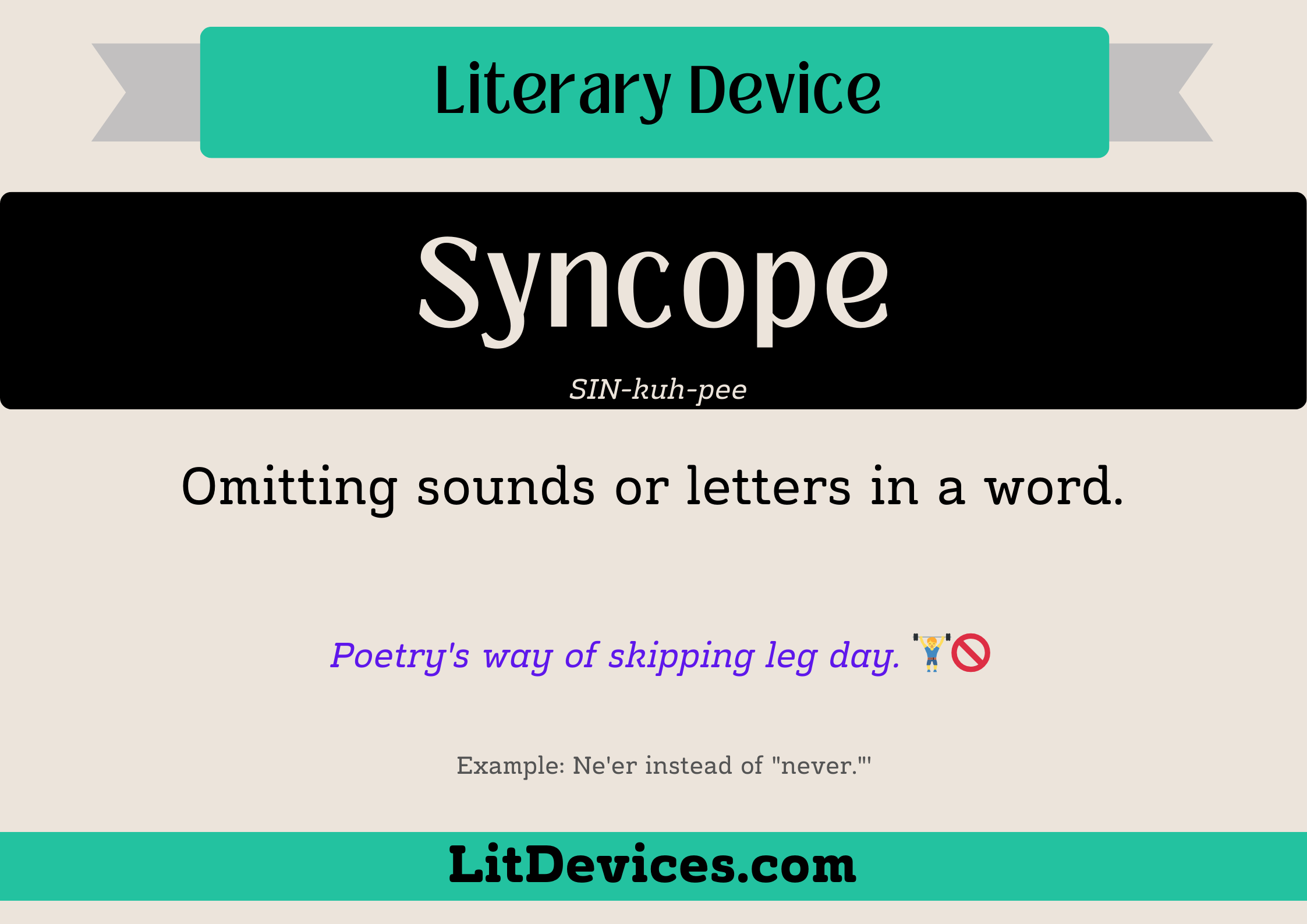Often confused with a fainting condition of the same name or musical syncopation, syncope is also a literary tool beloved of poets. Syncope allows the writer to remove syllables and letters seemingly at will, as long as they are removed from the middle of the troublesome word. Syncope is most commonly found in poetry, but may occur in other areas of writing. To learn more, continue reading.
What is Syncope?
Syncope is a literary tool that allows writers to shorten a word by removing or omitting letters. It is often referred to as a conjunction within a word. Syncope requires the omission of syllables or sounds from the middle of the word by removing consonants, vowels, or letters.
Syncope can make writing more rhythmic and allow the writer to create an informal sounding conversation. Fun fact: Syncope is often referred to as an “contraction within a word.”
How to pronounce syncope?
When do writers use Syncope?
Primarily used in poetry, syncope allows writers to create or enhance rhythm. In general, writers use syncope to conform to a specific metrical pattern by omitting syllables. In these cases, the meter remains the same and when read aloud, the syncopic word is hardly ever noticed because the beat and rhythm of the poem remain the same. Unlike other literary techniques, no one ever really gets used to removing or omitting syllables and letters from their words.
How to use Syncope?
When working with syncope, there are a few guidelines to follow. Please review the following list to better understand how to use syncope correctly in your writing.
- Unless you are in Britain, syncope is not typically applied to vowels. When a vowel is the target of syncope, the vowel must be stressless within the word it is located. Example: Opera becomes opra after being shortened.
- Know your stress conditions. Know which vowels are stressed. A word, such as parliament, is considered syncopic when a vowel in the middle is unstressed such as the “I” in parliament.
- Know that in poetry, syncope refers to the dropping or removal of a consonant or unstressed vowel.
And in Poetry . . . ✍🏽
William Shakespeare poem, Sonnet 18 Shakespeare removes letters from the words at the end of lines two and four in this passage. If he had not done so, the poem would not have been written in iambic pentameter, Shakespeare’s favorite poetic style.
“But thy eternal summer shall not fade,
Nor lose possession of that fair thou ow’st,
Nor shall death brag thou wand’rest in his shade,When in eternal lines to time thou grow’st.”
In Edgar Allen Poe’s, “The Raven,” Poe also uses syncope at the end of his lines. In Poe’s poem, the omission of the harsh “v” sound allows hom to maintain the lyrical quality “The Raven ” is so well-known for.
“This and more I sat divining, with my head at ease reclining
On the cushion’s velvet lining that the lamp-light gloated o’er,
But whose velvet-violet lining with the lamp-light gloating o’er”
We hope you’ve enjoyed reading about syncope and have found this article useful. For information about other common literary devices and tools, please check out our other entries.
FAQ 🤔
What is syncope in literature?
Syncope is a literary and phonetic device involving the omission of sounds or letters from within a word to create a contraction or to fit the rhythm of a verse. It is commonly used in poetry to maintain the meter or enhance the flow of the language.
How does syncope enhance a text?
Can syncope be found in both poetry and prose?
Why do writers use syncope?
Writers use syncope to achieve a specific poetic meter or to emphasize certain sounds and rhythms in their writing. It allows for the compression of words to fit a particular structure without altering their essential meaning, enabling a smoother flow and greater flexibility in language expression.
How can I identify syncope in a text?
To identify syncope in a text, look for words where letters or syllables have been omitted but the word still retains its original meaning. Common examples include the omission of vowels or the shortening of words (e.g., ‘o’er’ for ‘over,’ ‘e’er’ for ‘ever’). These contractions often reflect the spoken language and can indicate the writer’s attempt to adhere to a particular metrical pattern or create a specific tone.

